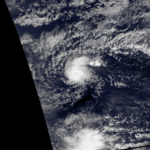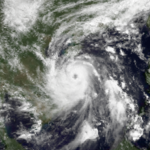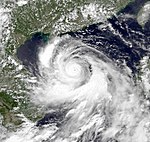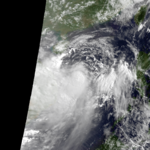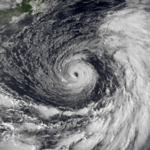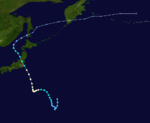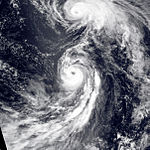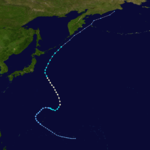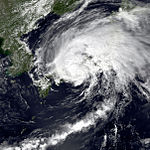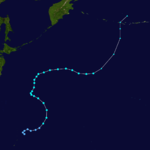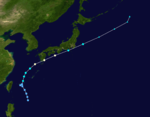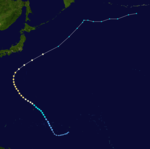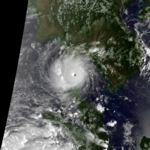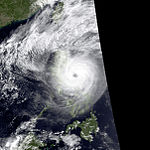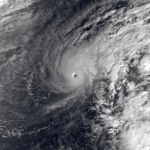1989 Pacific typhoon season
| 1989 Pacific typhoon season | |
|---|---|
Gordon and Elsie | |
| • Maximum winds | 185 km/h (115 mph) (10-minute sustained) |
| • Lowest pressure | 915 hPa (mbar) |
| Seasonal statistics | |
| Total depressions | 55 |
| Total storms | 32 |
| Typhoons | 20 |
| Super typhoons | 5 (unofficial) |
| Total fatalities | 3,328 total |
| Total damage | $2.24 billion (1989 USD) |
| Related articles | |
The 1989 Pacific typhoon season was the first of six consecutive years of above-average activity in the Western Pacific. It was an extremely active season spawning 32 tropical storms, 20 typhoons and five super typhoons. It has no official bounds; it ran year-round in 1989, but most
The scope of this article is limited to the Pacific Ocean, north of the equator and between
Season summary

Throughout 1989, several large-scale factors across the western Pacific Ocean displaced unusual characteristics that presented unique difficulties to forecasters. In their annual tropical cyclone report for 1989, the Joint Typhoon Warning Center regarded the season as one of the most challenging and unique years in their history. During much of the year, a very broad
The season began with the unusual development of Tropical Storm Winona east of the
In early July, a surge in the monsoon trough over the basin resulted in the development of Tropical Storm Faye. While this system was over the Philippines, Typhoon Gordon developed underneath a TUTT cell to the east. Following Gordon's rapid intensification phase, a new tropical storm developed within an area of enhanced divergence associated with the same TUTT cell. Several days later, the monsoon trough became exceptionally active and spawned several consecutive cyclones in late-July: Irving over the South China Sea, Judy near the Mariana Islands, 12W near Taiwan, and Ken–Lola around the Ryukyu Islands. The development of seven tropical cyclones in July made it the most active July since 1973. The extreme activity continued into August with the formations of Mac, Nancy, Owen, Peggy, and 19W, all of which formed within the monsoon trough. The rapid succession of Nancy, Owen, and Peggy led to several days of binary interaction between the systems well to the south of Japan. Tropical Storm Roger developed near the Ryukyu Islands a few days after 19W dissipated and rapidly tracked northeastward through Japan. This was the only storm of the month not to develop within the monsoon trough. The final system of August, 21W, developed to the northeast of Guam and dissipated due to strong wind shear.[3]
Heavy rains alongside several typhoons between June and September resulted in deadly flooding across parts of Anhui, Hebei, Hubei, Jiangsu, Jiangxi, Jilin, Sichuan, and Zhejiang provinces in China. The floods killed approximately 3,000 people and overall losses reached $2.7 billion.[4]
Systems
Tropical Storm Winona
| Tropical storm (JMA) | |
| Tropical storm (SSHWS) | |
| Duration | January 15 (Entered basin) – January 21 |
|---|---|
| Peak intensity | 65 km/h (40 mph) (10-min); 991 hPa (mbar) |
On January 15, Tropical Storm Winona crossed the International Date Line and entered the Western Pacific basin. Embedded within broad easterly flow, the storm turned west-southwestward, a heading it would retain until dissipation, and accelerated. This acceleration caused slight strengthening of the storm by enhancing winds on the north side of the low.[5]
On January 16, Winona passed approximately 140 km (87 mi) south of Wake Island. Operationally, it was not until January 18 that the JTWC began issuing warnings on the system.[5] At the same time, the JMA assessed Winona to have been a weak tropical storm with winds of 65 km/h (40 mph).[6] Around 0700 UTC on January 18, the ship MV Williams passed close to or through the center of Winona and measured a pressure of 991 mbar (991 hPa; 29.3 inHg) alongside 85 km/h (55 mph) sustained winds with gusts up to 130 km/h (80 mph). This was the only direct measurement in relation to the cyclone. Early on January 19, the JTWC assessed Winona to have reached its peak intensity with 100 km/h (60 mph) winds as it passed just north of Saipan. Later that day, convection quickly diminished as Winona moved into a shallow air mass-produced by polar system to the north. The system maintained only intermittent convection for another day before making landfall in the central Philippines. The storm quickly weakened and dissipated on January 22 as it emerged into the South China Sea.[5]
Before dissipating, the remnants of Winona tracked through the Philippines; however, no known impact resulted from its passage. Throughout its nearly two week existence, Winona traveled approximately 10,185 km (6,329 mi) across the Pacific Ocean.[5]
Typhoon Andy
| Very strong typhoon (JMA) | |
| Category 5 super typhoon (SSHWS) | |
| Duration | April 17 – April 24 |
|---|---|
| Peak intensity | 185 km/h (115 mph) (10-min); 920 hPa (mbar) |
Thunderstorm activity increased in coverage near Truk/Chuuk in the Caroline Islands on April 13. The system slowly developed, organizing into a tropical depression on April 18 while moving slowly to the west. On April 19, Andy began to move northward while continuing to intensify. The intense cyclone missed Guam by 130 kilometres (81 mi) to the southeast, with winds peaking at 68 knots (126 km/h) on Guam. Thereafter, Andy recurved to the northeast and steadily weakened due to increased vertical wind shear out of the west, dissipating as a tropical cyclone on April 24. Andy became the second typhoon to form in April in nine years.[7]
Prior to Typhoon Andy's arrival, 14
Typhoon Brenda (Bining)
| Typhoon (JMA) | |
| Category 1 typhoon (SSHWS) | |
| Duration | May 14 – May 21 |
|---|---|
| Peak intensity | 120 km/h (75 mph) (10-min); 970 hPa (mbar) |
A tropical depression which formed in the monsoon trough on May 14 became a tropical storm on May 16 and struck
On May 16, storm warnings were issued for 20 provinces across the Philippines as Brenda approached the country. Multiple commercial vessels were kept at port until the storm passed.[12] Throughout the country, Brenda killed at least 18 people and left 6,000 more homeless. Additionally, 52 people were reported missing.[13]
Severe Tropical Storm Cecil
| Severe tropical storm (JMA) | |
| Category 1 typhoon (SSHWS) | |
| Duration | May 22 – May 26 |
|---|---|
| Peak intensity | 110 km/h (70 mph) (10-min); 975 hPa (mbar) |
Cecil originated as a tropical depression over the
Typhoon Dot (Kuring)
| Typhoon (JMA) | |
| Category 3 typhoon (SSHWS) | |
| Duration | June 4 – June 12 |
|---|---|
| Peak intensity | 150 km/h (90 mph) (10-min); 955 hPa (mbar) |
Originating from a tropical disturbance near
Throughout its course, Typhoon Dot produced heavy rains in the Philippines, China and Vietnam, resulting in significant damage and eight fatalities. The most severe impacts took place on Hainan Island where 1,400 homes were destroyed and another 60,000 were damaged.[21] In Vietnam, Dot killed six people and exacerbated flooding triggered in late May by Tropical Storm Cecil.[22]
Severe Tropical Storm Ellis (Daling)
| Severe tropical storm (JMA) | |
| Tropical storm (SSHWS) | |
| Duration | June 18 – June 24 |
|---|---|
| Peak intensity | 95 km/h (60 mph) (10-min); 985 hPa (mbar) |
Developing as a disturbance in the Philippine Sea on June 18, the system moved westward initially and became a tropical depression late on June 20 and weakened on June 21. Early on June 23, the large system with gales well removed from its center became a tropical depression once more. A trough to its northwest had deepened, which was accelerating the cyclone northward. It became a minimal tropical storm during this acceleration. Late that day, it became a frontal wave before moving through Japan into the Sea of Japan.[23]
Tropical Storm Ellis produced rain over much of Japan, with the heaviest falling around Tokyo where rainfall rates reached 53 mm (2.1 in) per hour. Between June 23 and 24, 343 mm (13.5 in) of rain fell in the city, much of which fell in a 24-hour span. Several areas also recorded tropical storm force winds.[24]
Severe Tropical Storm Faye (Elang)
| Severe tropical storm (JMA) | |
| Tropical storm (SSHWS) | |
| Duration | July 6 – July 11 |
|---|---|
| Peak intensity | 100 km/h (65 mph) (10-min); 980 hPa (mbar) |
On July 6 a tropical depression formed west of Luzon. Tracking generally westward, the system soon strengthened into Tropical Storm Faye. On July 8, the storm struck the Philippines as a severe tropical storm before moving into the South China Sea. Struggling to regain strength, the system subsequently made landfall in northern
Typhoon Gordon (Goring)
| Very strong typhoon (JMA) | |
| Category 5 super typhoon (SSHWS) | |
| Duration | July 9 – July 19 |
|---|---|
| Peak intensity | 185 km/h (115 mph) (10-min); 915 hPa (mbar) |
Originating from a single cluster of thunderstorms on July 9, Gordon developed into a tropical depression near the
Throughout Gordon's path from the Philippines to China, the storm caused widespread damage and loss of life.
Tropical Storm Hope (Huling)
| Tropical storm (JMA) | |
| Tropical storm (SSHWS) | |
| Duration | July 16 – July 21 |
|---|---|
| Peak intensity | 85 km/h (50 mph) (10-min); 990 hPa (mbar) |
A tropical depression formed in the wake of Super Typhoon Gordon on July 16. The depression moved towards the northwest and strengthened into Tropical Storm Hope. Hope moved approximately 100 miles (160 km) south of
Following on the heels of
Throughout
Severe Tropical Storm Irving (Ibiang)
| Severe tropical storm (JMA) | |
| Tropical storm (SSHWS) | |
| Duration | July 18 – July 24 |
|---|---|
| Peak intensity | 100 km/h (65 mph) (10-min); 985 hPa (mbar) |
Tropical Storm Irving formed in the South China Sea west of the Philippines on July 21. Although hampered by northerly sheer Irving intensified to a peak of 65 mph (105 km/h) just before landfall in northern Vietnam.[32]
Striking Vietnam as a strong tropical storm, Irving brought widespread heavy rain that caused damaging floods. Parts of
Typhoon Judy
| Very strong typhoon (JMA) | |
| Category 2 typhoon (SSHWS) | |
| Duration | July 20 – July 29 |
|---|---|
| Peak intensity | 155 km/h (100 mph) (10-min); 940 hPa (mbar) |
Originating from a
In Japan, damaging winds from the typhoon left approximately 4 million people without power.[41] Significant flooding in the country resulted in 11 deaths and $28.9 million in damage.[42][43][44] In South Korea, heavy rains from the storm exacerbated ongoing floods, leading to at least 20 fatalities.[45] Flooding from the remnants of Judy affected the Soviet Far East, temporarily severing the Trans-Siberian Railway and killing 15 people.[46]
Tropical Depression 12W (Miling)
| Tropical depression (SSHWS) | |
| Duration | July 27 – July 31 |
|---|---|
| Peak intensity | 55 km/h (35 mph) (1-min); 1000 hPa (mbar) |
TD 12W developed out of an active monsoon trough and moved westward for the duration of its existence, never attaining tropical storm status due to high wind shear. After the tropical depression moved over northern Taiwan, The low-level center decoupled from the mid-level center in the Taiwan Strait, and advisories were discontinued.
Between July 26 and 30, heavy rains fell across parts of Taiwan, resulting in deadly floods. At least 16 people perished while 2 others were reported missing. Sixty-three homes were destroyed and forty-two others were damaged by the floods. Nearly 1,000 hectares (2,500 acres) of farmland were inundated, resulting in $31.78 million in losses. Infrastructural damage across the country amounted to $15.74 million. In the wake of the floods, the Government of Taiwan pledged to provide relief funds to those left homeless and family of the deceased.[47]
Severe Tropical Storm Ken–Lola
| Severe tropical storm (JMA) | |
| Tropical storm (SSHWS) | |
| Duration | July 29 – August 7 |
|---|---|
| Peak intensity | 100 km/h (65 mph) (10-min); 980 hPa (mbar) |
The monsoon trough spawned a tropical depression on July 29. Poorly organized, it moved quickly northeastward and became a tropical storm on July 30. Operationally, Tropical Storm Ken continued northeastward with the rest of the convection, with Tropical Storm Lola forming further westward, but the ill-defined circulation actually continued westward, leading to one storm with two names. Ken–Lola turned to the southwest, stalling before heading northwest again. Ken–Lola reached a peak of 65 mph (105 km/h) winds before hitting eastern China on August 3, causing little damage as it slowly dissipated until August 7.[48] Ken–Lola shows the troubles of tracking poorly organized systems. A more recent example is Tropical Depression 32W/33W in 1995.
Heavy rains associated with Tropical Storm Ken–Lola affected much of Japan as it meandered south of the country for several days. In Tokyo, the storm produced 195 mm (7.7 in) of rain, leading to several mudslides and flash flooding. Areas along the Kanda River were inundated after the river overflowed its banks. At least nine people were killed in and around Tokyo while seventeen others were reported missing.[49]
Striking the Chinese coastline near Shanghai, rains from Tropical Storm Ken–Lola caused the Huangpu River to rise above its warning level; however, no damage was reported.[50]
Typhoon Mac
| Typhoon (JMA) | |
| Category 1 typhoon (SSHWS) | |
| Duration | July 30 – August 8 |
|---|---|
| Peak intensity | 150 km/h (90 mph) (10-min); 950 hPa (mbar) |
Moving around the northeast side of Ken–Lola, and then an upper tropospheric cyclone, Mac moved along a wide northwest arc before settling on a north-northwest track into Japan as a typhoon on August 6, dissipating over
Typhoon Nancy
| Typhoon (JMA) | |
| Category 1 typhoon (SSHWS) | |
| Duration | August 11 – August 16 |
|---|---|
| Peak intensity | 130 km/h (80 mph) (10-min); 965 hPa (mbar) |
Typhoon Owen
| Typhoon (JMA) | |
| Category 1 typhoon (SSHWS) | |
| Duration | August 11 – August 18 |
|---|---|
| Peak intensity | 140 km/h (85 mph) (10-min); 960 hPa (mbar) |
Tropical Storm Peggy
| Tropical storm (JMA) | |
| Tropical storm (SSHWS) | |
| Duration | August 16 – August 18 |
|---|---|
| Peak intensity | 65 km/h (40 mph) (10-min); 996 hPa (mbar) |
A short lived tropical storm existed near the Northern Mariana Islands in mid-August. Forming on August 16, Peggy attained minimal tropical storm status before succumbing to wind shear and dissipating on August 18.
Tropical Depression 19W
| Tropical depression (SSHWS) | |
| Duration | August 16 – August 19 |
|---|---|
| Peak intensity | 55 km/h (35 mph) (1-min); 1000 hPa (mbar) |
On August 16, a large area of low pressure centered about 335 km (208 mi) northwest of
Severe Tropical Storm Roger (Narsing)
| Severe tropical storm (JMA) | |
| Tropical storm (SSHWS) | |
| Duration | August 24 – August 28 |
|---|---|
| Peak intensity | 100 km/h (65 mph) (10-min); 975 hPa (mbar) |
A tropical disturbance began to organize just to the north of
Tropical Storm Roger produced significant rainfall across the majority of Japan, affecting areas from the Ryukyu Islands to Hokkaido. The heaviest rains fell over the Kii Peninsula and Shikoku, with 505 and 464 mm (19.9 and 18.3 in) measured in Hidegadake, Nara and Kubokawa, Kōchi respectively.[52] These rains triggered widespread flooding that killed at least three people.[53] In Osaka, a train derailed and crashed into a buffer, resulting in 50 injuries. It is unknown if the accident was the result of Roger, though many trains at the time were cancelled due to flooding.[54] At least 1,071 homes were flooded across the country and numerous roads were washed out.[55]
Tropical Storm 21W
| Tropical storm (JMA) | |
| Tropical depression (SSHWS) | |
| Duration | August 23 – August 29 |
|---|---|
| Peak intensity | 65 km/h (40 mph) (10-min); 1002 hPa (mbar) |
On August 23, a tropical depression formed well to the north-northeast of Guam. Tracking northeast, the depression struggled to intensify amidst wind shear. According to the JMA, the system attained tropical storm intensity on August 26. By August 27, the storm weakened due to persistent shear and later dissipated on August 29.
Typhoon Sarah (Openg)
| Typhoon (JMA) | |
| Category 4 typhoon (SSHWS) | |
| Duration | September 3 – September 14 |
|---|---|
| Peak intensity | 150 km/h (90 mph) (10-min); 950 hPa (mbar) |
Originating from a disturbance within a
While the typhoon meandered near the Philippines, it brought several days of heavy rain to much of Luzon, triggering extensive flash flooding. At least 44 people perished across the country and another 200,000 were left homeless.[27] Striking Taiwan as a strong typhoon, Sarah caused widespread wind damage that left approximately 840,000 residents without power.[57] Excessive rainfall associated with the storm triggered flooding that washed away highways and inundated about 40,500 hectares (100,000 acres) of farmland.[58] Throughout the island, Sarah was responsible for 19 fatalities and at least US$171 million (4.38 billion New Taiwan dollars) in damage.[21][59] Four deaths also took place on the Gotō Islands.[60] Additionally, four deaths took place offshore and another seventeen people were listed as missing.[21][61]
Severe Tropical Storm Tip
| Severe tropical storm (JMA) | |
| Tropical storm (SSHWS) | |
| Duration | September 8 – September 14 |
|---|---|
| Peak intensity | 95 km/h (60 mph) (10-min); 985 hPa (mbar) |
Tip formed along the eastern portion of the
Severe Tropical Storm Vera (Pining)
| Severe tropical storm (JMA) | |
| Tropical storm (SSHWS) | |
| Duration | September 11 – September 16 |
|---|---|
| Peak intensity | 100 km/h (65 mph) (10-min); 980 hPa (mbar) |
On September 10, an area of low-level convergence developed within a monsoon trough several hundred kilometres north of Guam. Following the development of persistent convection, the JTWC issued a TCFA early on September 11 before classifying it as a tropical depression 26 hours later. Initially, the system moved slowly and erratically before being steered west-northwest by a subtropical ridge. Shortly after being declared a depression, the system intensified into Tropical Storm Vera. Only modest strengthening took place thereafter, with the system attaining peak winds of 95 km/h (60 mph). Accelerating towards China, Vera gradually weakened due to increasing wind shear. After passing 185 km (115 mi) south of Okinawa on September 14, the storm made landfall about 240 km (150 mi) south of Shanghai the next day. Once onshore, Vera weakened to a tropical depression as it turned northward.[63] The remnants of Vera later transitioned into an extratropical cyclone on September 16 as it emerged over the Yellow Sea. The system tracked east-northeast for several days, passing over South Korea and northern Japan before moving over north Pacific Ocean. Vera was last noted as a powerful system near the International Date Line on September 19 with a central pressure of 964 mbar (hPa; 28.47 inHg).[6]
Although only a tropical storm at landfall, torrential rains associated with Vera triggered widespread flooding throughout eastern China.[64] Damage from the storm was regarded as the worst in 27 years.[65] Large parts of Zhejiang Province were inundated by the storm, including the port city of Shujiang. Early reports indicated that at least 190 people were injured near Shanghai.[64] Two days after the storm, only scarce reports on the scale of damage were available. On September 18, officials announced over national television that at least 72 people were killed and hundreds were missing. By then, workers began repairing damaged coastlines and building up stone sea walls.[66] According to the nation's flood control officials, approximately 347,000 hectares (860,000 acres) of farmland and 16,000 hectares (40,000 acres) of crops were flooded by the storm. At least 162 people were killed and another 354 were listed as missing. Additionally, 692 people were injured by the storm.[67] Immense structural losses took place throughout the province with 3.1 million homes damaged or destroyed. Additionally, 430 km (270 mi) of coastal dykes and 174 km (108 mi) of irrigation ditches were washed away.[68] Total losses throughout Zhejiang Province reached $351 million.[67] Significant losses also took place in nearby Jiangsu Province where 34 people were killed and an estimated 2,000 more were injured. Approximately 590,000 hectares (1.5 million acres) of farmland was inundated by the storm and total losses reached $485,000.[68] Throughout eastern China, approximately 5.86 million households (23 million people) were affected by flooding triggered by the storm.[69] According to the news estimates, a total of 500–700 people died as a result of Vera.[63]
Typhoon Wayne
| Typhoon (JMA) | |
| Category 1 typhoon (SSHWS) | |
| Duration | September 17 – September 20 |
|---|---|
| Peak intensity | 130 km/h (80 mph) (10-min); 970 hPa (mbar) |
Typhoon Wayne formed from a depression on September 17 about 100 miles (160 km) southwest of
Throughout Japan, Wayne produced rainfall in excess of 200 mm (7.9 in), peaking at 313 mm (12.3 in), that triggered flash flooding and mudslides. In parts of Kōchi Prefecture, rainfall rates reached 83 mm (3.3 in) per hour.[70] According to Japanese Police, the storm caused 166 mudslides and affected 33 of the country's 49 prefectures.[71] Eight people were killed by the storm,[70] including three children who drowned after falling into a swollen river.[72] A total of 247 homes were destroyed and another 5,824 were damaged.[70]
Typhoon Angela (Rubing)
| Very strong typhoon (JMA) | |
| Category 4 super typhoon (SSHWS) | |
| Duration | September 28 – October 10 |
|---|---|
| Peak intensity | 175 km/h (110 mph) (10-min); 925 hPa (mbar) |
The first in a series of tropical cyclones to develop within the monsoon trough, Angela was first identified as a tropical depression on September 28. Initially, a shortwave trough caused the system to move north-northwest; however, once this feature moved away from Angela, the cyclone acquired a general westward track. Developing dual outflow channels on October 1, Angela rapidly intensified into a Category 4 equivalent typhoon. After maintaining its strength for four days, the storm intensified into a super typhoon on October 5 with peak winds estimated at 240 km/h (150 mph).[73] At this time, the JMA assessed Angela to have attained ten-minute winds of 175 km/h (110 mph) and a minimum pressure of 925 mbar (hPa; 27.32 inHg).[74] Later that day, the storm skirted the northern coast of Luzon before moving into the South China Sea. Considerable weakening took place due to the interaction with the Philippines and the system was slow to re-organize. In response to a ridge over China, Angela turned to the west-southwest. On October 9, the storm brushed the southern coast of Hainan Island before making landfall near Huế, Vietnam. Once onshore, Angela rapidly dissipated and was last noted during the afternoon of October 10.[73]
Throughout northern Luzon, high winds and heavy rains from the typhoon destroyed 14,064 homes and damaged 19,245 more. Angela was the deadliest in the series of storms to strike the Philippines with 119 fatalities; another 28 people were reported missing.[27] Total economic losses from the storm reached $8 million.[75] Significant damage took place on Hainan Island and in Vietnam but specifics are unknown due to the rapid succession of storms.[21][76]
Typhoon Brian
| Typhoon (JMA) | |
| Category 1 typhoon (SSHWS) | |
| Duration | September 28 – October 3 |
|---|---|
| Peak intensity | 120 km/h (75 mph) (10-min); 970 hPa (mbar) |
Originating from an
Across Hainan Island, Brian caused extensive damage to property and infrastructure. Nearly 185,000 homes were damaged or destroyed by the storm's high winds or flash flooding. Communications were severely disrupted as 2,800 km (1,700 mi) of power and telephone lines were downed. Brian killed 40 people and inflicted 837 million Renminbi (US$222 million) in damage throughout Hainan before striking Vietnam and causing further damage.[21] Significant losses were reported in Vietnam as well; however, the rapid succession of Brian and two other typhoons made it difficult to differentiate the losses caused by each storm.[76]
Typhoon Colleen
| Typhoon (JMA) | |
| Category 1 typhoon (SSHWS) | |
| Duration | October 1 – October 8 |
|---|---|
| Peak intensity | 150 km/h (90 mph) (10-min); 950 hPa (mbar) |
On October 2, a tropical storm warning was issued for Guam and the Northern Mariana Islands as Colleen approached.[78] As a precautionary measure, U.S. military installations relocated aircraft to Japan and sent ships to sea to ride out the storm.[79]
Typhoon Dan (Saling)
| Typhoon (JMA) | |
| Category 1 typhoon (SSHWS) | |
| Duration | October 6 – October 13 |
|---|---|
| Peak intensity | 140 km/h (85 mph) (10-min); 960 hPa (mbar) |
The second of three typhoons to strike Vietnam in October, Dan developed on October 6, and tracked generally westward throughout its course. Initially, intensification was somewhat limited due to its proximity to Typhoon Angela; however, by October 9 conditions became more favorable and Dan attained typhoon status.[80] After crossing the Philippines, the typhoon emerged into the South China Sea and reached its peak intensity, with sustained 10-minute winds of 140 km/h (85 mph) and a minimum barometric pressure of 960 mbar (hPa; 28.35 inHg).[74] After brushing the southern coast of Hainan Island, a weakened Dan made landfall in northern Vietnam before dissipating on October 13.[80]
The storm caused extensive damage throughout its course. In the Philippines, Dan left more than 232,000 homeless and killed 58 people.[27][80] Though not the strongest in the series of typhoons to affect the Philippines, Dan was the costliest with total economic losses reaching $59.2 million.[75] Roughly 95 percent of Metro Manila was left without power and some areas remained in the dark for weeks.[80] Across Vietnam, heavy rains from Dan exacerbated ongoing floods and caused further damage to areas recovering from Typhoons Angela and Brian.[76] Approximately 130,000 hectares (320,000 acres) of land was flooded by the storm.[80]
Typhoon Elsie (Tasing)
| Very strong typhoon (JMA) | |
| Category 5 super typhoon (SSHWS) | |
| Duration | October 13 – October 22 |
|---|---|
| Peak intensity | 185 km/h (115 mph) (10-min); 915 hPa (mbar) |
A powerful
In the Philippines, Elsie worsened the situation already left in the wakes of typhoons Angela and Dan. Although it was stronger than the previous two, Elsie caused far less damage due to the relatively sparse population in the area of landfall. During the storm's passage, 47 people were killed and another 363 were injured. Damages throughout the country amounted to $35.4 million and roughly 332,000 people were left homeless.[27][75]
Typhoon Forrest
| Very strong typhoon (JMA) | |
| Category 2 typhoon (SSHWS) | |
| Duration | October 18 – October 30 |
|---|---|
| Peak intensity | 155 km/h (100 mph) (10-min); 940 hPa (mbar) |
The last of the tropical cyclones in October and the 17th typhoon of the year, Forrest was slow to develop initially near the Marshall Islands as it was a large cyclone. Once it passed Guam by only 85 mi (137 km), it intensified into a typhoon, with maximum sustained winds peaking at 95 knots (109 mph). Tree limbs and power lines were downed as the system pulled away from Saipan. It then recurved, accelerating northeast to become of the strongest extratropical cyclones in the Pacific Ocean that year.[82]
Typhoon Gay
| Very strong typhoon (JMA) | |
| Category 3 typhoon (SSHWS) | |
| Duration | November 1 – November 4 (Exited basin) |
|---|---|
| Peak intensity | 165 km/h (105 mph) (10-min); 960 hPa (mbar) |
Typhoon Hunt (Unsing)
| Typhoon (JMA) | |
| Category 2 typhoon (SSHWS) | |
| Duration | November 16 – November 23 |
|---|---|
| Peak intensity | 140 km/h (85 mph) (10-min); 960 hPa (mbar) |
A tropical disturbance began to organize and a tropical depression formed east of the
Offshore, large swells produced by the storm sank a boat off the coast of
Typhoon Irma (Walding)
| Very strong typhoon (JMA) | |
| Category 5 super typhoon (SSHWS) | |
| Duration | November 21 – December 4 |
|---|---|
| Peak intensity | 175 km/h (110 mph) (10-min); 925 hPa (mbar) |
Typhoon Irma formed on November 21 as a minimal cyclone. Irma did not intensify at first, as it moved over lukewarm waters for most of its early life. But as it moved over warm waters, it rapidly intensified to a strong typhoon. The storm intensified from a category 1 to a category 3 in less than 2+1⁄2 days, and rapidly intensified from a Category 3 to a Category 5 in 12 hours. Then, Irma began to weaken as it traveled over very cool waters near the Philippines. Irma then weakened and dissipated two days later on December 4.
Tropical Depression 35W
| Tropical depression (SSHWS) | |
| Duration | December 1 – December 9 |
|---|---|
| Peak intensity | 55 km/h (35 mph) (1-min); 1000 hPa (mbar) |
This strong Tropical Depression did not affect land much as it lasted for eight days, mostly churning in open ocean.
Typhoon Jack
| Very strong typhoon (JMA) | |
| Category 4 typhoon (SSHWS) | |
| Duration | December 21 – December 27 |
|---|---|
| Peak intensity | 175 km/h (110 mph) (10-min); 925 hPa (mbar) |
On December 25, a level two tropical cyclone condition of readiness was issued for Guam as Typhoon Jack stalled about 320 km (200 mi) east of the territory.[86] On December 26, several B-52s were relocated from Anderson Air Force Base to Okinawa and the United States Navy ordered vessels to ride out the storm at sea. Banks across Guam were also closed that day and officials in Saipan advised residents to stock up on emergency supplies.[87] Following the storm's dramatic weakening on December 27, it was no longer deemed a major threat to the region.[88]
Other systems
In addition to the storms listed above, the
- January 26–28, 55 km/h (35 mph) 1002 mbar (hPa; 29.59 inHg)[89]
- In late January, heavy rains affected much of Samar Island, resulting in widespread flooding. In some areas, flood waters reached depths of 1.2 m (3.9 ft).[90] At least 35 people died as a result of the floods and agricultural losses were estimated at $5 million.[91] The flooding was soon worsened as several days of monsoonal rains followed in early February. By February 7, at least 61 people had been killed and many more were reported missing.[92]
- In late January, heavy rains affected much of
- June 24–27, 55 km/h (35 mph) 1002 mbar (hPa; 29.59 inHg)[93]
- August 9–12, 55 km/h (35 mph) 1000 mbar (hPa; 29.53 inHg)[94]
- August 18–22, 45 km/h (30 mph) 1002 mbar (hPa; 29.59 inHg)[95]
- August 19–23, 55 km/h (35 mph) 1005 mbar (hPa; 29.68 inHg)[96]
- December 5–6, 55 km/h (35 mph) 1002 mbar (hPa; 29.59 inHg)[97]
- December 8–9, 55 km/h (35 mph) 1002 mbar (hPa; 29.59 inHg)[98]
Storm names
During the season 32 named tropical cyclones developed in the Western Pacific and were named by the Joint Typhoon Warning Center, when it was determined that they had become tropical storms. These names were contributed to a revised list which started on 1979. However the JTWC changed their naming list during half-way of 1989, starting with the name Angela.
| Winona | Andy | Brenda | Cecil | Dot | Ellis | Faye | Gordon | Hope | Irving | Judy | Ken | Lola | Mac | Nancy | Owen |
| Peggy | Roger | Sarah | Tip | Vera | Wayne | Angela | Brian | Colleen | Dan | Elsie | Forrest | Gay | Hunt | Irma | Jack |
Philippines
| Atring | Bining | Kuring | Daling | Elang |
| Goring | Huling | Ibiang | Luming | Miling |
| Narsing | Openg | Pining | Rubing | Saling |
| Tasing | Unsing | Walding | Yeyeng | |
| Auxiliary list | ||||
|---|---|---|---|---|
| Anding (unused) | ||||
| Binang (unused) | Kadiang (unused) | Dinang (unused) | Epang (unused) | Gundang (unused) |
The
Season effects
This is a table of all of the storms that have formed in the 1989 Pacific typhoon season. It includes their duration, names, affected areas, damages, and death totals. Deaths in parentheses are additional and indirect (an example of an indirect death would be a traffic accident), but were still related to that storm. Damage and deaths include totals while the storm was extratropical, a wave, or a low, and all of the damage figures are in 1989 USD. Names listed in parentheses were assigned by PAGASA.
| Name | Dates | Peak intensity | Areas affected | Damage (USD) |
Deaths | Refs | ||
|---|---|---|---|---|---|---|---|---|
| Category | Wind speed | Pressure | ||||||
| Winona | January 15–21 | Tropical storm | 65 km/h (40 mph) | 1,000 hPa (29.53 inHg) | Wake Island, Mariana Islands, Caroline Islands | None | None | |
| Atring | January 26–28 | Tropical depression | Not specified | 1,002 hPa (29.59 inHg) | Philippines | $5 million | 61 | |
| Andy | April 17–25 | Typhoon | 185 km/h (115 mph) | 920 hPa (27.17 inHg) | Caroline Islands, Mariana Islands | None | None | |
| Brenda (Bining) | May 15–21 | Typhoon | 120 km/h (75 mph) | 970 hPa (28.64 inHg) | Philippines, South China | $2.86 million | 104 | |
| Cecil | May 22–26 | Severe tropical storm | 110 km/h (70 mph) | 975 hPa (28.79 inHg) | Vietnam, Laos, Thailand | $71.7 million | 751 | |
| TD | June 3 | Tropical depression | Not specified | 1,006 hPa (29.71 inHg) | None | None | None | |
| Dot (Kuring) | June 4–12 | Typhoon | 150 km/h (95 mph) | 955 hPa (28.20 inHg) | Philippines, South China, Vietnam | $45.1 million | 8 | |
| Ellis (Daling) | June 20–24 | Severe tropical storm | 95 km/h (60 mph) | 985 hPa (29.09 inHg) | Japan | None | None | |
| TD | June 25–26 | Tropical depression | Not specified | 1,004 hPa (29.65 inHg) | None | None | None | |
| Faye (Elang) | July 6–11 | Severe tropical storm | 100 km/h (60 mph) | 980 hPa (28.94 inHg) | Philippines, South China | None | None | |
| Gordon (Goring) | July 11–19 | Typhoon | 185 km/h (115 mph) | 915 hPa (27.02 inHg) | Mariana Islands, Philippines, South China | $381 million | 306 | |
| Hope (Huling) | July 15–22 | Tropical storm | 85 km/h (55 mph) | 990 hPa (29.23 inHg) | Ryukyu Islands, East China | $340 million | 198 | |
| Irving (Ibiang) | July 19–24 | Severe tropical storm | 100 km/h (60 mph) | 985 hPa (29.09 inHg) | Philippines, Vietnam | Unknown | 104 | |
| Judy | July 11–19 | Typhoon | 155 km/h (95 mph) | 940 hPa (27.76 inHg) | Japan, Korean Peninsula | $30.7 million | 46 | |
| 12W (Miling) | July 27–31 | Tropical depression | 55 km/h (35 mph) | 996 hPa (29.41 inHg) | Taiwan | None | None | |
| Ken-Lola | July 28 – August 7 | Severe tropical storm | 100 km/h (60 mph) | 980 hPa (28.94 inHg) | Ryukyu Islands, China | Unknown | 9 | |
| Mac | July 30 – August 8 | Typhoon | 150 km/h (95 mph) | 950 hPa (28.05 inHg) | Japan | None | None | |
| TD | July 31 – August 2 | Tropical depression | Not specified | 996 hPa (29.41 inHg) | None | None | None | |
| Owen | August 9–19 | Typhoon | 140 km/h (85 mph) | 960 hPa (28.35 inHg) | Caroline Islands, Mariana Islands | None | None | |
| TD | August 10–11 | Tropical depression | Not specified | 1,002 hPa (29.59 inHg) | Vietnam, South China | None | None | |
| Nancy | August 11–16 | Typhoon | 130 km/h (80 mph) | 965 hPa (28.50 inHg) | Japan | None | None | |
| Peggy | August 15–19 | Tropical storm | 65 km/h (40 mph) | 996 hPa (29.41 inHg) | Mariana Islands | None | None | |
| 19W | August 16–20 | Tropical depression | 55 km/h (35 mph) | 996 hPa (29.41 inHg) | Ryukyu Islands, Taiwan, East China | None | None | |
| TD | August 18–23 | Tropical depression | Not specified | 1,004 hPa (29.65 inHg) | Ryukyu Islands | None | None | |
| TD | August 19–11 | Tropical depression | Not specified | 1,008 hPa (29.77 inHg) | None | None | None | |
| TD | August 19–23 | Tropical depression | Not specified | 1,008 hPa (29.77 inHg) | None | None | None | |
| TD | August 22–25 | Tropical depression | Not specified | 1,008 hPa (29.77 inHg) | South China, Vietnam | None | None | |
| TD | August 23–25 | Tropical depression | Not specified | 1,002 hPa (29.59 inHg) | None | None | None | |
| Roger | August 23–28 | Severe tropical storm | 100 km/h (60 mph) | 980 hPa (28.94 inHg) | Taiwan | Unknown | 3 | |
| 21W | August 24–28 | Tropical storm | 65 km/h (40 mph) | 1,002 hPa (29.59 inHg) | None | None | None | |
| TD | August 29–30 | Tropical depression | Not specified | 1,016 hPa (30.00 inHg) | None | None | None | |
| TD | August 31 – September 2 | Tropical depression | Not specified | 1,004 hPa (29.65 inHg) | None | None | None | |
| TD | September 3–4 | Tropical depression | Not specified | 1,004 hPa (29.65 inHg) | None | None | None | |
| TD | September 3–5 | Tropical depression | Not specified | 1,002 hPa (29.59 inHg) | Japan | None | None | |
| TD | September 4 | Tropical depression | Not specified | 1,002 hPa (29.59 inHg) | Japan | None | None | |
| Sarah (Openg) | September 5–14 | Typhoon | 150 km/h (95 mph) | 950 hPa (28.05 inHg) | Philippines, Taiwan, Ryukyu Islands, China | $175 million | 71 | |
| Tip | August 23–28 | Severe tropical storm | 95 km/h (60 mph) | 985 hPa (29.09 inHg) | None | None | None | |
| TD | September 8 | Tropical depression | Not specified | 1,002 hPa (29.59 inHg) | Vietnam | None | None | |
| TD | September 8–9 | Tropical depression | Not specified | 1,004 hPa (29.65 inHg) | None | None | None | |
| Vera (Pining) | September 11–16 | Severe tropical storm | 100 km/h (60 mph) | 980 hPa (28.94 inHg) | Ryukyu Islands, Taiwan, East China | $352 million | 500 | |
| TD | September 16 | Tropical depression | Not specified | 1,008 hPa (29.77 inHg) | None | None | None | |
| Wayne | September 17–20 | Typhoon | 120 km/h (75 mph) | 975 hPa (28.79 inHg) | Japan, South Korea | None | 8 | |
| TD | September 17–19 | Tropical depression | Not specified | 1,004 hPa (29.65 inHg) | South China | None | None | |
| Angela (Rubing) | September 28 – October 10 | Typhoon | 175 km/h (110 mph) | 925 hPa (27.32 inHg) | Philippines, Vietnam | $8 million | 119 | |
| Brian | September 28 – October 4 | Typhoon | 120 km/h (75 mph) | 970 hPa (28.64 inHg) | South China, Vietnam | $222 million | 40 | |
| Colleen | October 1–8 | Typhoon | 150 km/h (95 mph) | 950 hPa (28.05 inHg) | Caroline Islands, Mariana Islands | None | None | |
| Dan (Saling) | October 8–14 | Typhoon | 140 km/h (85 mph) | 960 hPa (28.35 inHg) | Caroline Islands, Philippines, Vietnam, South China | $59.2 million | 109 | |
| Elsie (Tasing) | October 13–22 | Typhoon | 185 km/h (115 mph) | 915 hPa (27.02 inHg) | Philippines, South China, Vietnam | $35.4 million | 47 | |
| Forrest | October 21–29 | Typhoon | 155 km/h (95 mph) | 940 hPa (27.76 inHg) | Caroline Islands | None | None | |
| Gay | October 31 – November 4 | Typhoon | 165 km/h (105 mph) | 935 hPa (27.61 inHg) | Thailand | $497 million | 833 | |
| Hunt (Unsing) | November 15–24 | Typhoon | 140 km/h (85 mph) | 960 hPa (28.35 inHg) | Caroline Islands, Philippines | $350,000 | 11 | |
| Irma (Walding) | November 20 – December 4 | Typhoon | 175 km/h (110 mph) | 925 hPa (27.32 inHg) | Caroline Islands | None | None | |
| 35W | December 5–9 | Tropical depression | 55 km/h (35 mph) | 1,002 hPa (29.59 inHg) | Caroline Islands | None | None | |
| Yeyeng | December 9–12 | Tropical depression | 55 km/h (35 mph) | 1,004 hPa (29.65 inHg) | None | None | None | |
| Jack | December 21–28 | Typhoon | 175 km/h (110 mph) | 925 hPa (27.32 inHg) | Caroline Islands, Mariana Islands | None | None | |
| Season aggregates | ||||||||
| 55 systems | January 15 – December 28, 1989 | 185 km/h (115 mph) | 915 hPa (27.02 inHg) | $2.22 billion | 3,328 | |||
See also
- 1989 Pacific hurricane season
- 1989 Atlantic hurricane season
- 1989 North Indian Ocean cyclone season
- South-West Indian Ocean cyclone seasons: 1988–89, 1989–90
- Australian region cyclone seasons: 1988–89, 1989–90
- South Pacific cyclone seasons: 1988–89, 1989–90
Notes
References
- ^ Gary Padgett. May 2003 Tropical Cyclone Summary. Archived 2010-11-30 at the Wayback Machine Retrieved 2006-08-26.
- ^ "Worst Natural Disaster". Bangkok, Thailand: New Straits Times. Reuters. June 1, 1989. p. 15F. Retrieved March 2, 2013.
- ^ a b c Joint Typhoon Warning Center (1990). Western North Pacific Tropical Cyclones (PDF) (1989 Annual Tropical Cyclone Report). United States Navy. pp. 22–26. Archived from the original (PDF) on February 21, 2013. Retrieved June 13, 2012.
- ^ "Weather Catastrophes in China 1980 – 2010" (PDF). Munich Reinsurance Company. January 2011. Archived from the original (PDF) on July 18, 2013. Retrieved February 28, 2013.
- ^ a b c d Lt. Ryan R. Shultz (1990). "1989 Annual Tropical Cyclone Report: Tropical Storm Winona (01W)" (PDF). Joint Typhoon Warning Center. United States Navy. pp. 32–36. Archived from the original (PDF) on June 6, 2011. Retrieved March 4, 2013.
- ^ .TXT) on December 5, 2014. Retrieved March 2, 2013.
- ^ Joint Typhoon Warning Center. 1989 Joint Typhoon Warning Center Tropical Cyclone Reports for the Northwest Pacific and North Indian Oceans. Archived 2011-06-07 at the Wayback Machine Retrieved on 2008-11-26.
- ^ a b "Typhoon Andy spawns strong winds off Guam". Agana, Guam. United Press International. April 21, 1989. – via LexisNexis (subscription required)
- ^ a b c "Typhoon Bypassing U.S. Territory". Agana, Guam. Associated Press. April 21, 1989. – via LexisNexis (subscription required)
- ^ "Territories". USA Today. Virgin Islands. April 24, 1989. – via LexisNexis (subscription required)
- ^ Joint Typhoon Warning Center. Typhoon Brenda. Retrieved on 2007-01-20.
- ^ "Storm Brenda Intensifies, Nears Central Philippines". Associated Press News. Manila, Philippines. May 16, 1989.
- ^ "Storm leaves 18 dead". Manila Bulletin. Manila, Philippines. Xinhua General Overseas News Service. May 19, 1989. – via LexisNexis (subscription required)
- ^ a b Cpt. John D. Pickle (1990). "1989 Annual Tropical Cyclone Report: Typhoon Cecil (04W)" (PDF). Joint Typhoon Warning Center. United States Navy. pp. 50–51. Archived from the original (PDF) on February 21, 2013. Retrieved March 2, 2013.
- ^ "Tropical storm". Ellensburg Daily Record. Bangkok, Thailand. United Press International. May 29, 1989. p. 12. Retrieved March 2, 2013.
- ^ "Country Disaster Response Handbook: Vietnam" (PDF). Center for Excellence in Disaster Management & Humanitarian Assistance. October 2012. p. 9. Retrieved March 2, 2013.
- ^ "Typhoon kills 140 in Vietnam". Hanoi, Vietnam. Xinhua General News. May 31, 1989. – via LexisNexis (subscription required)
- ^ "Central official tours province affected by typhoon". BBC. June 7, 1989. – via LexisNexis (subscription required)
- ^ "Viet Nam Cyclone Cecil May 1989 UNDRO Situation Reports 1–3". United Nations Department of Humanitarian Affairs. ReliefWeb. June 16, 1989. Retrieved March 2, 2013.
- ^ Ens Richard L. Jeffries (1990). "1989 Annual Tropical Cyclone Report: Typhoon Dot (05W)" (PDF). Joint Typhoon Warning Center. United States Navy. pp. 52–55. Archived from the original (PDF) on February 21, 2013. Retrieved January 5, 2012.
- ^ a b c d e f "The 1989 Pacific Typhoon Season Summary" (PDF). Hong Kong Observatory. 1990. Archived from the original (PDF) on October 23, 2019. Retrieved March 28, 2012.
- ^ Steve Newman (June 18, 1989). "Earthweek: A Diary of the Planet". Toronto Star. p. B6. – via LexisNexis (subscription required)
- ^ Joint Typhoon Warning Center. Tropical Storm Ellis. Retrieved on 2007-01-20.
- ^ "台風198906号 (Ellis) – 災害情報" (in Japanese). National Institute of Informatics. 2011. Retrieved December 18, 2011.
- ^ Cpt. Ann R. Ostdiek (1990). "1989 Annual Tropical Cyclone Report: Tropical Storm Faye (07W)" (PDF). Joint Typhoon Warning Center. United States Navy. pp. 60–62. Archived from the original (PDF) on June 6, 2011. Retrieved January 14, 2012.
- ^ a b 1st Lt. Robert J. Falvey (1990). "1989 Annual Tropical Cyclone Report: Typhoon Gordon (08W)" (PDF). Joint Typhoon Warning Center. United States Navy. pp. 64–68. Archived from the original (PDF) on February 21, 2013. Retrieved March 27, 2012.
{{cite web}}: CS1 maint: numeric names: authors list (link) - ^ a b c d e f "Destructive Typhoons 1970–2003". National Disaster Coordinating Council. November 9, 2004. Archived from the original on November 9, 2004. Retrieved February 1, 2012.
- ^ "Toll from summer rains climbs to 1,400 in China". The Toronto Star. Beijing, China. Reuters. July 19, 1989. p. A19. – via LexisNexis (subscription required)
- ^ "Typhoon Lola to Hit Shanghai". Shanghai, China. Xinhua General News. August 3, 1989. – via LexisNexis (subscription required)
- ^ "14 Fishermen Perish". Palm Peach Post. Hong Kong. August 12, 1989. p. 6A. – via LexisNexis (subscription required)
- ^ "Typhoon Huling Spotted". The Manila Chronicle. Manila, Philippines. Xinhua General News. July 18, 1989. (accessed through LexisNexis)
- ^ a b c d e Joint Typhoon Warning Center. "Archived copy" (PDF). Archived from the original (PDF) on 2011-06-07. Retrieved 2010-01-26.
{{cite web}}: CS1 maint: archived copy as title (link) Retrieved on 2007-12-26. - ^ "Storm Leaves Thousands Homeless". Manila, Philippines. Associated Press. July 17, 1989. – via LexisNexis (subscription required)
- ^ "Rains, Flooding Kill 197 in China". Beijing, China. Associated Press. July 26, 1989. – via LexisNexis (subscription required)
- ^ "Storms kill 200 in eastern China". Beijing, China. United Press International. July 26, 1989. – via LexisNexis (subscription required)
- ^ "Typhoon Leaves 26 Dead, 33 Injured In Vietnam". Hanoi, Vietnam. Xinhua General News. July 26, 1989. – via LexisNexis (subscription required)
- ^ a b "Society and Environment; Typhoon damage in Thanh Hóa Province". British Broadcasting Company. Hanoi, Vietnam. August 9, 1989. – via LexisNexis (subscription required)
- ^ "Sixth typhoon of 1989 hits Vietnam". Bangkok, Thailand. United Press International. July 30, 1989. – via LexisNexis (subscription required)
- ^ "Viet Nam Typhoon Irving Aug 1989 UNDRO Situation Report No. 1". United Nations Department of Humanitarian Affairs. ReliefWeb. August 4, 1989. Retrieved December 10, 2011.
- ^ Cpt. Bruce W. Thompson (1990). "1989 Annual Tropical Cyclone Report: Typhoon Judy (11W)" (PDF). Joint Typhoon Warning Center. United States Navy. pp. 78–82. Archived from the original (PDF) on February 21, 2013. Retrieved January 7, 2012.
- ^ "Typhoon kills infant in Japan". Tokyo, Japan. United Press International. July 28, 1989. – via LexisNexis (subscription required)
- ^ "Killer Typhoons Heads for S. Korea". Japan Economic Newswire. Tokyo, Japan. July 28, 1989. – via LexisNexis (subscription required)
- ^ M.H. Ahn (July 28, 1989). "Typhoon Judy Hits Korean Peninsula". Seoul, South Korea. Associated Press. – via LexisNexis (subscription required)
- ^ "台風198911号 (Judy) – 災害情報" (in Japanese). National Institute of Informatics. 2012. Retrieved January 6, 2012.
- ^ 재난안전/정보화 통계 (in Korean). 행정 및 보안 부. October 31, 2008. Archived from the original (PDF) on February 3, 2016. Retrieved January 7, 2012.
- ^ "At least 15 die in Soviet Far East floods". Soviet Union: BBC. August 3, 1989. – via LexisNexis (subscription required)
- ^ "Taiwan Flood Toll Increases to 16". Taipei, Taiwan. Central News Agency. August 3, 1989. – via LexisNexis (subscription required)
- ^ Joint Typhoon Warning Center. "Tropical Storm Ken–Lola" (PDF). Archived from the original (PDF) on 2011-06-07. Retrieved 2007-01-20.
- ^ "At least 9 killed in Japanese storm". Globe and Mail. Tokyo, Japan. Reuters. August 3, 1989. – via LexisNexis (subscription required)
- ^ "Tropical Storm Hits Shanghai". Shanghai, China. Xinhua General News. August 4, 1989. – via LexisNexis (subscription required)
- ^ Joint Typhoon Warning Center. Typhoon Mac. Retrieved on 2007-01-20.
- ^ "台風198917号 (Roger) – 災害情報" (in Japanese). National Institute of Informatics. 2013. Retrieved March 10, 2013.
- ^ "Typhoon Heads for Toyama". Japan Economic Newswire. August 27, 1989. – via LexisNexis (subscription required)
- ^ "50 Injured in Osaka Train Accident". Japan Economic Newswire. August 27, 1989. – via LexisNexis (subscription required)
- ^ "Storm Leaves Three Dead, Three Missing as It Heads for Soviet Union". Tokyo, Japan. Associated Press. August 28, 1989. – via LexisNexis (subscription required)
- ^ Lt. Cdr. Nicholas D. Gural (1990). "1989 Annual Tropical Cyclone Report: Typhoon Sarah (22W)" (PDF). Joint Typhoon Warning Center. United States Navy. pp. 118–125. Archived from the original (PDF) on June 6, 2011. Retrieved December 28, 2011.
- ^ "Eight Killed, Nine Missing as Typhoon Sarah Hits Taiwan". Central News Agency. Taipei, Taiwan. September 12, 1989. – via LexisNexis (subscription required)
- ^ "6 dead, 8 missing in Typhoon Sarah's wake". Taipei, Taiwan. United Press International. September 12, 1989. (Accessed through LexisNexis)
- ^ "Typhoon Death Toll Rises To 19; More Rain Expected". Central News Agency. Taipei, Taiwan. September 13, 1989. – via LexisNexis (subscription required)
- ^ "4 Die In Goto Island Landslide". Japan Economic Newswire. Nagasaki, Japan. September 13, 1989. – via LexisNexis (subscription required)
- ^ "Search for Lung Hao's 4 Missing Crew Members Ends". Central News Agency. Hualien, Taiwan. September 14, 1989. – via LexisNexis (subscription required)
- ^ Joint Typhoon Warning Center. Tropical Storm Tip. Retrieved on 2007-01-20.
- ^ a b Lt. Dianne K. Crittenden (1990). "1989 Annual Tropical Cyclone Report: Tropical Storm Vera (24W)" (PDF). Joint Typhoon Warning Center. United States Navy. pp. 131–132. Archived from the original (PDF) on February 21, 2013. Retrieved March 2, 2013.
- ^ a b "Typhoon Kills at Least 48 in Coastal China". Beijing, China. Associated Press. September 16, 1989. – via LexisNexis (subscription required)
- ^ "Typhoon kills 48 in China". Beijing, China. United Press International. September 16, 1989. – via LexisNexis (subscription required)
- ^ "Typhoon Death Toll Up to 72, Hundreds Missing". Beijing, China. Associated Press. September 18, 1989. – via LexisNexis (subscription required)
- ^ a b "Death Toll from Typhoon Rises to 162". Beijing, China. Associated Press. September 20, 1989. – via LexisNexis (subscription required)
- ^ a b "China – Typhoon Vera Sep 1989 UNDRO Information Reports 1–2". United Nations Department of Humanitarian Affairs. ReliefWeb. September 29, 1989. Retrieved March 29, 2012.
- ^ "Relief Funds Allocated For Zhejiang Flood Victims". Hangzhou, China. Xinhua General News. October 13, 1989. – via LexisNexis (subscription required)
- ^ a b c "台風198922号 (Wayne) – 災害情報" (in Japanese). National Institute of Informatics. 2011. Retrieved December 29, 2011.
- ^ "Storms batter Japan". The Deseret News. Tokyo, Japan. United Press International. September 20, 1989. p. 6A. Retrieved December 29, 2011.
- ^ "Typhoon Wayne hits coast of Japan". Pittsburgh Post-Gazette. Tokyo, Japan. Associated Press. September 21, 1989. p. 10. Retrieved December 29, 2011.
- ^ a b Cpt. Bruce W. Thompson (1990). "1989 Annual Tropical Cyclone Report: Super Typhoon Angela (26W)" (PDF). Joint Typhoon Warning Center. United States Navy. pp. 138–141. Archived from the original (PDF) on February 21, 2013. Retrieved December 28, 2011.
- ^ .TXT) on December 5, 2014. Retrieved December 25, 2011.
- ^ a b c "October 1989 Philippine Typhoons Reports 1–6". World Food Council. ReliefWeb. November 3, 1989. Retrieved December 28, 2011.
- ^ a b c "Vietnam Typhoons Oct 1989 UNDRO Situation Reports 1–6". United Nations Department of Humanitarian Affairs. ReliefWeb. January 15, 1990. Retrieved December 28, 2011.
- ^ Ens Richard L. Jeffries (1990). "1989 Annual Tropical Cyclone Report: Typhoon Brian (27W)" (PDF). Joint Typhoon Warning Center. United States Navy. pp. 142–144. Archived from the original (PDF) on February 21, 2013. Retrieved April 23, 2012.
- Agana, Guam. Associated Press. October 2, 1989. – via LexisNexis (subscription required)
- ^ Jack Williams (October 3, 1989). "Southeastern rain taking ocean voyage". USA Today. p. 8A. – via LexisNexis (subscription required)
- ^ a b c d e Cpt. Ann R. Ostdiek (1990). "1989 Annual Tropical Cyclone Report: Typhoon Dan (29W)" (PDF). Joint Typhoon Warning Center. United States Navy. pp. 152–154. Archived from the original (PDF) on June 6, 2011. Retrieved December 28, 2011.
- ^ Lt. Bruce W. Thompson (1990). "1989 Annual Tropical Cyclone Report: Super Typhoon Elsie (30W)" (PDF). Joint Typhoon Warning Center. United States Navy. pp. 156–158. Archived from the original (PDF) on June 6, 2011. Retrieved December 28, 2011.
- ^ Joint Typhoon Warning Center. Typhoon Forrest. Retrieved on 2007-01-07.
- ^ G.S. Mandal & Akhilesh Gupta (1996). "The Wind Structure, Size and Damage Potential of Some Recent Cyclone of Hurricane Intensity in the North Indian Ocean". Advances in Tropical Meteorology (50). New Delhi, India: Indian Meteorological Society: 421.
- ^ "Philippines braces for Typhoon Hunt". Manila, Philippines. United Press International. November 21, 1989. – via LexisNexis (subscription required)
- ^ a b Jervina Lao (November 22, 1989). "Typhoon batters Philippines". Manila, Philippines. United Press International. – via LexisNexis (subscription required)
- ^ "Powerful Typhoon Threatens Guam, Saipan". Agana, Guam. Associated Press. December 25, 1989. – via LexisNexis (subscription required)
- ^ "Powerful Typhoon Threatens Guam, Saipan". Agana, Guam. Associated Press. December 26, 1989. – via LexisNexis (subscription required)
- ^ "Typhoon Downgraded to Tropical Depression". Agana, Guam. Associated Press. December 26, 1989. – via LexisNexis (subscription required)
- ^ "1989 Missing (1989026N11127)". International Best Track Archive. 2011. Archived from the original on 2012-04-26. Retrieved December 26, 2011.
- ^ "Floods hit eastern Philippines". Manila, Philippines. Xinhua General News. January 30, 1989. – via LexisNexis (subscription required)
- ^ "35 die after rains in the Philippines". The Globe and Mail. Manila, Philippines. Reuters. February 1, 1989. – via LexisNexis (subscription required)
- ^ "61 killed in floods, landslides in eastern philippines". Manila, Philippines. Xinhua General News. February 7, 1989. – via LexisNexis (subscription required)
- ^ "1989 Missing (1989176N14114)". International Best Track Archive. 2011. Archived from the original on 2012-04-26. Retrieved December 26, 2011.
- ^ "1989 Missing (1989221N17115)". International Best Track Archive. 2011. Archived from the original on 2012-04-26. Retrieved December 26, 2011.
- ^ "1989 Missing (1989230N17137)". International Best Track Archive. 2011. Archived from the original on 2012-04-26. Retrieved December 29, 2011.
- ^ "1989 Missing (1989231N22154)". International Best Track Archive. 2011. Archived from the original on 2012-04-26. Retrieved December 29, 2011.
- ^ "1989 Missing (1989339N10145)". International Best Track Archive. 2011. Archived from the original on 2012-04-26. Retrieved December 29, 2011.
- ^ "1989 Missing (1989343N14137)". International Best Track Archive. 2011. Archived from the original on 2012-04-26. Retrieved December 29, 2011.
External links
- China Meteorological Agency
- Digital Typhoon
- Hong Kong Observatory
- Japan Meteorological Agency
- Joint Typhoon Warning Center
- Korea Meteorological Administration
- Malaysian Meteorological Department
- National Weather Service Guam
- Philippine Atmospheric, Geophysical and Astronomical Services Administration
- Taiwan Central Weather Bureau
- TCWC Jakarta
- Thai Meteorological Department
- Typhoon2000
- Vietnam's National Hydro-Meteorological Service
- Satellite movie of 1989 Pacific typhoon season

